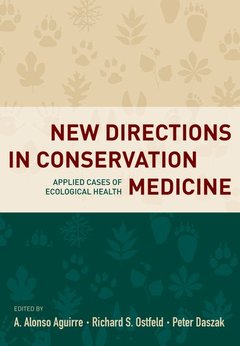New Directions in Conservation Medicine Applied Cases of Ecological Health
Langue : Anglais
Coordonnateurs : Aguirre A. Alonso, Ostfeld Richard, Daszak Peter

In recent years, species and ecosystems have been threatened by many anthropogenic factors manifested in local and global declines of populations and species. Although we consider conservation medicine an emerging field, the concept is the result of the long evolution of transdisciplinary thinking within the health and ecological sciences and the better understanding of the complexity within these various fields of knowledge. Conservation medicine was born from the cross fertilization of ideas generated by this new transdisciplinary design. It examines the links among changes in climate, habitat quality, and land use; emergence and re-emergence of infectious agents, parasites and environmental contaminants; and maintenance of biodiversity and ecosystem functions as they sustain the health of plant and animal communities including humans. During the past ten years, new tools and institutional initiatives for assessing and monitoring ecological health concerns have emerged: landscape epidemiology, disease ecological modeling and web-based analytics. New types of integrated ecological health assessment are being deployed; these efforts incorporate environmental indicator studies with specific biomedical diagnostic tools. Other innovations include the development of non-invasive physiological and behavioral monitoring techniques; the adaptation of modern molecular biological and biomedical techniques; the design of population level disease monitoring strategies; the creation of ecosystem-based health and sentinel species surveillance approaches; and the adaptation of health monitoring systems for appropriate developing country situations. New Directions of Conservation Medicine: Applied Cases of Ecological Health addresses these issues with relevant case studies and detailed applied examples. New Directions of Conservation Medicine challenges the notion that human health is an isolated concern removed from the bounds of ecology and species interactions. Human health, animal health, and ecosystem health are moving closer together and at some point, it will be inconceivable that there was ever a clear division.
Introduction. (A. Alonso Aguirre and Sara E. Howard). Part I: Conservation Medicine: Ecological Health in Practice. 1. Conservation Medicine: Ontogeny of an Emerging Discipline. A. Alonso Aguirre, G.M. Tabor and Richard S. Ostfeld. 2. EcoHealth: Creating a Truly a Global Transdiscipline. Bruce A. Wilcox, Pierre Horwitz, and A. Alonso Aguirre. 3. One Health, One Medicine. Laura H. Kahn, Thomas P. Monath, Bob H. Bokma, Paul Gibbs, A. Alonso Aguirre. 4. Biodiversity and Human Health. Aaron Bernstein. 5. An Ecosystem Service of Biodiversity - The Protection of Human Health Against Infectious Disease. Felicia Keesing and Richard S. Ostfeld. 6. Parasite Conservation, Conservation Medicine and Ecosystem Health. Andres Gomez, Elizabeth Nichols and Susan L. Perkins. 7. Stress and Immunosuppression as Factors in the Decline and Extinction of Populations: The Concepts, the Evidence and the Challenges. Heribert Hofer and Marion L. East. Part II: Anthropogenic Change and Conservation Medicine. 8. Predicted Impacts of Climate on Emerging Diseases: A Model for Global Change. Raina K. Plowright, Paul C. Cross, Gary M. Tabor, Emily Almberg, Leslie Bienen, and Peter Hudson. 9. Wildlife Health in a Changing North: A Model for Global Environmental Change. Morten Tryland, Susan Kutz and Patricia Curry. 10. Habitat Fragmentation and Infectious Disease Ecology. Gerardo Suzan, Fernando Esponda, Roberto Carrasco-Hernandez, A. Alonso Aguirre. 11. Wildlife Trade and the Spread of Disease. Katherine F. Smith, Lisa M. Schloegel, and Gail E. Rosen. 12. Bushmeat and Infectious Disease Emergence. Matthew LeBreton, Brian L. Pike, Karen E. Saylors, Joseph L. Diffo, Joseph N. Fair, Anne W. Rimoin, Nancy Ortiz, Cyrille F. Djoko, Ubald Tamoufe, Nathan D. Wolfe. 13. Human Migration, Border Controls and Infectious Disease Emergence. Anne M. Alexander, David C. Finnoff and Jason F. Shogren. Part III: Emerging Infectious Diseases and Conservation Medicine. 14. Are Bats Exceptional Viral Reservoirs?. Kevin J. Olival, Jonathan H. Epstein, Lin-Fa Wang, Hume E. Field and Peter Daszak. 15. SARS: A Case Study for Factors Driving Disease Emergence. Wolfgang Preiser. 16. H5N1 Highly Pathogenic Avian Influenza: Breaking the Rules in Disease Emergence. Thijs Kuiken and Timm Harder. 17. Bartonellosis: An Emerging Disease of Humans, Domestic Animals and Wildlife. Ricardo G. Maggi, Craig A. Harms, Edward B. Breitschwerdt. 18. Brucella ceti and Brucella pinnipedialis Infections in Marine Mammals. Jacques Godfroid, Ingebjorg Nymo, Morten Tryland, Axel Cloeckaert, Thierry Jauniaux, Adrian M. Whatmore, Edgardo Moreno, Geoffrey Foster. 19. Infectious Cancers in Wildlife. Hamish McCallum and Menna Jones. 20. From Protozoan Infection in Monarch Butterflies to Colony Collapse Disorder in Bees: Are Emerging Infectious Diseases Proliferating in the Invertebrate World?. Rebecca Bartel and Sonia Altizer. 21. Fungal Diseases in Neotropical Forests Disturbed by Humans. Julieta Benitez-Malvido. 22. Emerging Infectious Diseases in Fisheries and Aquaculture. E. Scott Weber. 23. Southern Sea Otters: Sentinels of Land-Sea Pathogens and Pollutants. David A. Jessup and Melissa A. Miller. Part IV: Ecotoxicology and Conservation Medicine. 24. Ecotoxicology: Bridging Wildlife, Humans and Ecosystems. Jeffrey M. Levengood and Val R
Alonso Aguirre is Executive Director of the Smithsonian-Mason Global Conservation Studies Program based at Smithsonian Conservation Biology Institute in Front Royal, and Associate Professor at the Department of Environmental Science and Policy in George Mason University, Fairfax, Virginia. He cofounded the emerging discipline of Conservation Medicine and has over 20 years of experience in conservation of biodiversity wildlife medicine and management in over 23 countries. Rick Ostfeld is Senior Scientist and Animal Ecologist at the Cary Institute of Ecosystem Studies, Millbrook, New York. Peter Daszak is President of EcoHealth Alliance (formerly Wildlife Trust). He is a leader in the field of conservation medicine and a respected disease ecologist.
Date de parution : 06-2012
Ouvrage de 672 p.
25.4x18.3 cm
Thèmes de New Directions in Conservation Medicine :
© 2024 LAVOISIER S.A.S.



